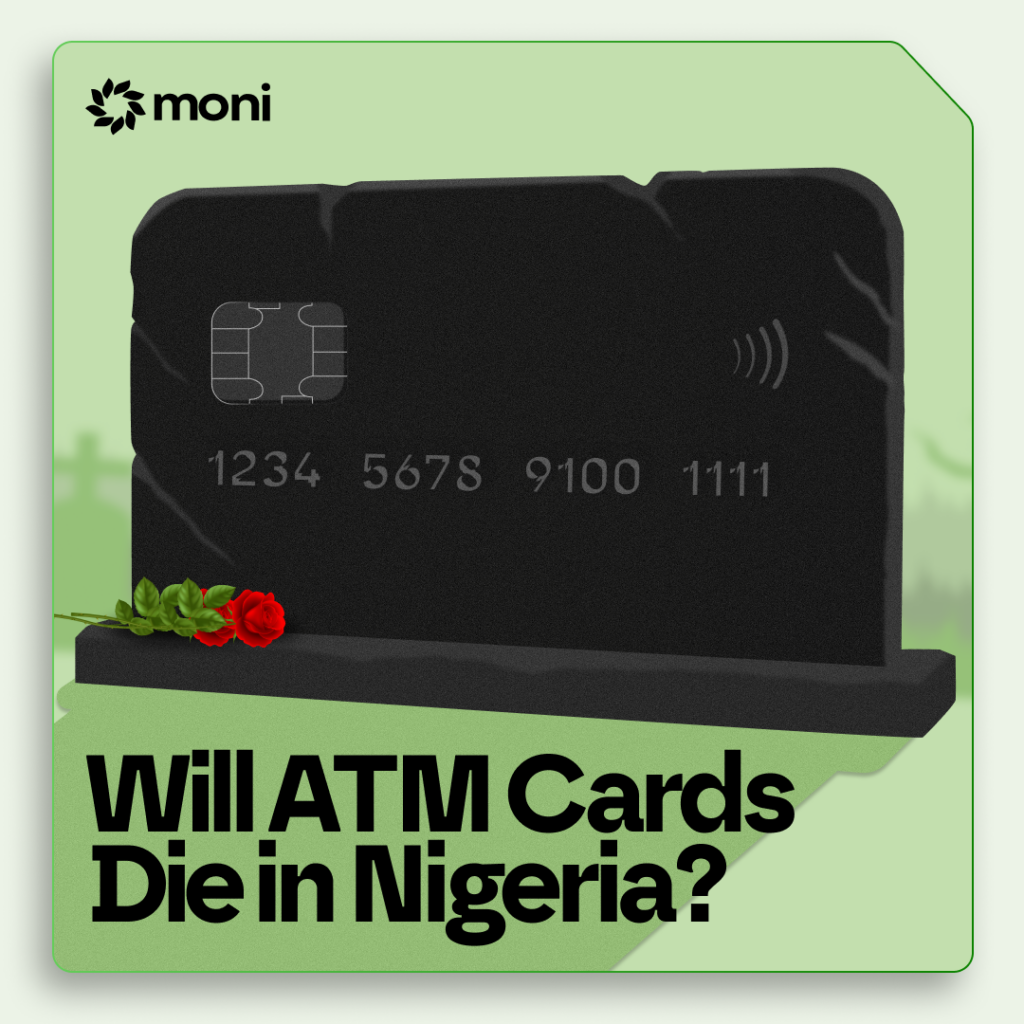
“Savings or Current?“
That’s the question you hear right after handing your ATM card to a shop attendant or fuel station cashier. For many Nigerians, that simple question has become a familiar part of everyday transactions and with it, the well-worn, plastic ATM card that slips into their wallet soon after. For over three decades, ATM cards have been at the heart of how we spend, save, and withdraw money. They’ve helped us escape long banking queues, make late-night withdrawals, and shop both online and offline. But in today’s world of QR codes, mobile wallets, and tap-to-pay, are these cards slowly becoming relics of the past?
In this piece, we take a closer look at the rise of ATM cards in Nigeria, the shift toward contactless and other digital payments, and whether we’re headed toward a future where cards no longer have a place in our pockets.
A History of Digital Payments in Nigeria
Nigeria’s payment ecosystem has always been a fascinating blend of the traditional and the innovative. On one hand, open-air markets still run on face-to-face cash transactions. On the other, smartphones and apps have turned everyday Nigerians into agents of digital finance, transferring money with a few taps.
The road to digital payments in Nigeria began in the 1980s with the introduction of electronic banking, pioneered by “new generation” banks like Diamond Bank, which introduced online, real-time interconnectivity for customer accounts. This marked a major shift from manual banking to more automated, customer-focused services.
By the early 1990s, Automated Teller Machines (ATMs) began to appear, allowing people to access their money without stepping into a bank branch. The first ATM was deployed by Societe Generale Bank of Nigeria (now Heritage Bank) in 1989. While this was a big leap, the service remained elitist — many Nigerians still saw banks as institutions for the upper class.
The mid-90s saw the introduction of smartcards by the Central Bank of Nigeria (CBN) in 1993. However, widespread adoption remained a challenge due to infrastructure gaps and the public’s deep-rooted trust in cash.
Things took a transformative turn in the early 2000s. In 2002, Interswitch, founded by Mitchell Elegbe, emerged to address the absence of domestic payment infrastructure. Interswitch enabled interbank ATM withdrawals, a big deal at the time, and laid the foundation for scalable digital transactions in Nigeria. Alongside players like Paga and Remita, the country’s payment infrastructure began to mature rapidly.
In 2004, the Nigerian Interbank Settlement System (NIBSS) introduced the NIBSS Electronic Fund Transfers (NEFT) to enable seamless interbank payments. This further advanced electronic banking across the country.
Still, one major hurdle remained: security. The early days of card adoption were plagued with fraud due to the use of magnetic stripe cards, which were easy to clone. This prompted the CBN to mandate chip-and-pin technology in 2012, a key decision that restored some measure of public confidence in card transactions.
That same year, Interswitch launched Verve International, Nigeria’s first domestic card scheme. Verve cards could be produced locally and paid for in naira, reducing dependency on expensive foreign-issued cards and significantly increasing card circulation.
From 2016 onward, the entry of neobanks like ALAT by WEMA Bank introduced another wave of disruption. These digital-only banks provided full-service banking including card issuance without physical branches.
As the Central Bank’s 2008 economic report put it, “the rise in the use of electronic payments was sustained… reflecting the aggressive marketing strategy of the banks and increased public awareness.” ATMs accounted for 87% of all e-banking transactions then, proving how critical they had become.
Today, digital payments in Nigeria have gone beyond banking. With embedded fintech solutions now appearing in transport, education, and even healthcare, financial technology is no longer just a sector, it’s part of the national infrastructure.
The Rise of ATM Cards in Nigeria
The rise of ATM cards tells a compelling story of how far Nigeria’s financial system has come and how much trust consumers have gradually placed in digital systems.
In recent years the numbers speak for themselves. In 2022, the Nigerian cards and payments market was valued at $22 billion. That year alone saw 1.5 billion ATM transactions and 3.5 billion POS transactions. Even in a cash-reliant society, these figures show a massive shift toward card-based payments.
Statistics from Moniepoint shows that 8 out of 10 Nigerians now choose cards over transfers when paying for goods and services. And while Nigeria remains a largely cash-driven economy, card payments are challenging that tradition.
By 2023, card payments accounted for over 37% of online retail transactions in Nigeria, higher than bank visits and even cash transfers. Verve International reported issuing over 50 million cards that year, making it Africa’s largest domestic card network. Considering the low-trust environment and preference for physical cash in Nigeria, these figures are a powerful signal of growing confidence in digital finance.
The growth of ATM cards can also be attributed to the rise of digital financial services. Today, over 200 fintech startups operate in Nigeria’s payment space, offering everything from virtual cards to tap-to-pay features. The role of regulators like the CBN and NIBSS has been crucial in maintaining stability and fostering innovation.
Beyond payments, ATM cards have helped shape a more inclusive financial culture. With options ranging from student-friendly debit cards to virtual cards for online shopping, Nigerians now have more access and flexibility than ever before. The card revolution has also enabled interoperability between banks, creating a seamless experience whether you’re withdrawing from an ATM in Lagos or paying for groceries in Kano.
Yet, challenges remain. Issues like card fraud, network downtimes, and customer education still hinder full adoption. This raises a crucial question about the future of payment in Nigeria, considering the promise and pitfalls of contactless technology.
Will Contactless Payments Replace ATM Cards in Nigeria?
The popular sentiment in Nigeria’s payment industry is that we may be approaching the twilight of ATM card dominance. As the country’s appetite for faster, more seamless payment experiences grows, contactless payments, once seen as futuristic, are quickly becoming a viable alternative.
Contactless payments use Near-Field Communication (NFC) technology, allowing users to make payments by simply tapping a card or smartphone on a compatible Point-of-Sale (POS) terminal. This process requires no physical contact and takes less than a second, making it significantly faster than inserting a card or entering a PIN.
For mobile payments, users can store their card details on smartphones using apps like Google Pay, Apple Pay, or even banking apps. For smaller purchases, users often don’t need to enter a PIN, and this convenience is one of the biggest selling points of contactless payments.
The growing focus on contactless technology in Nigeria’s payments industry has been largely enabled by the Central Bank of Nigeria’s formal framework. In June 2023, the CBN issued detailed guidelines to regulate and promote contactless payments, providing the structure needed for broader industry adoption. This policy move laid the foundation for banks and fintechs to explore and expand contactless solutions. The cash crunch experienced during the 2023 naira redesign further encouraged consumers to embrace alternative payment methods, creating fertile ground for adoption. Banks are expected to drive contactless adoption through physical cards, while fintechs may lean into mobile-based contactless solutions — both approaches backed by regulatory support.
Despite the optimism, a few hurdles remain. Many Nigerians are unaware that their cards may be contactless enabled. Education and merchant training are critical. Security is another concern. Without authentication, contactless payments may be seen as riskier, especially with fraud cases on the rise. To manage this, the CBN has capped daily contactless transactions at ₦50,000. Still, simple safeguards, like optional PINs or FaceID, could increase consumer confidence.
Will Nigerians adopt contactless payments, or will it suffer the same fate as QR payments?
QR code payments once promised to revolutionize Nigeria’s payment system with instant transfers and no need for physical cards. But that promise fizzled out due to the CBN’s failure to enforce QR standards consistently across banks. Without system-wide interoperability, QR payments became more of a novelty than a true alternative to cards.
So, Will Cards Disappear?
The infrastructure is already in place. Most POS terminals in Nigeria today are NFC-enabled, and many newly issued cards come ready for contactless use. The security systems to support this payment method are also well-established. On paper, everything is set.
But infrastructure alone doesn’t guarantee adoption.
The real question is: will Nigerians embrace contactless payments the same way they adopted ATM cards?
Unlike the leap from cash to cards, contactless doesn’t require a new tool — just a new habit. It’s not about discarding the card, but changing how it’s used: from inserting or swiping to simply tapping. The shift is subtle, but the behavior change it demands may not be so simple.
In a country where new technology adoption tends to lag global trends, it’s uncertain whether this convenience will be enough to drive mass behavior change. Nigerians are known to stick to what works, and traditional methods like card inserts and bank transfers still feel reliable to many.
So, while contactless has a head start in infrastructure and security, its future depends on whether users see enough practical value to change how they pay. If banks and fintechs push hard and if everyday experiences make “tap to pay” feel effortless and rewarding, widespread adoption could follow.
ATM cards may not die out completely anytime soon. But their dominance will likely erode, especially in urban areas where digital payment behaviour is more entrenched. In the same way cash didn’t disappear overnight, cards will coexist with contactless options, at least for a while. Contactless payments won’t replace ATM cards because it’s trendier, it will replace them if it becomes more practical. And if Nigeria’s biggest fintechs and banks get behind it, that shift may happen sooner than we think.



